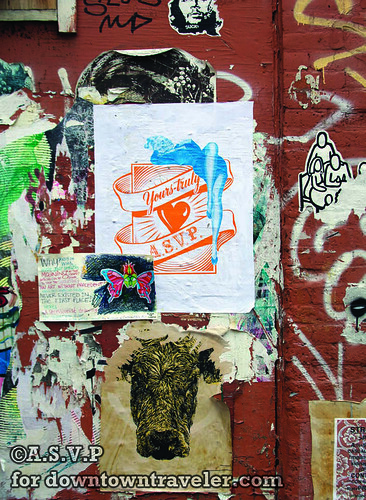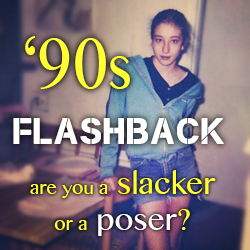If you live in a thriving metropolis– New York, London and Hong Kong come to mind– then you’ve probably stumbled across the work of ASVP.
This street art duo is known for eye-catching posters influenced by comic books, Mad Men-era advertising and even Lady Gaga.
In this revealing interview, Downtown Traveler uncovers the inspiration behind ASVP’s work, their artistic process, and their take on the blurring definition of street art.
If you are in Denver, Colorado this month, be sure to check out ASVP’s first solo gallery show at the Black Book Gallery (see below for details).
Given the legal issues surrounding street art, the members of ASVP closely guard their identities and declined to reveal exactly how they distribute their work. This Q+A was conducted over email and with a voice-mail from an unlisted phone number.
Several questions come from Downtown Traveler readers who submitted them through Twitter and Facebook.
Inspiration: East Meets West

Q: What and who inspires you the most? (Question submitted by Jeff Titelius of EuroTravelogue via Twitter)
A: There are many individuals that inspire us, from Nelson Mandela to Lady Gaga. Rather than a list of names, what we actually try to dial-in on are the energies that these individuals collectively create in the world. We focus on hooking into these kinds of forces for inspiration. For us, these influences engender things like individuality, creativity, progress and compassion.
Q: How did you get the brilliant idea for doing such beautiful street art, in terms of idea and subject? (Question submitted by Adam Jamal via Facebook)
A: The inspiration behind starting ASVP honestly came from us deciding to stop wasting our time doing things that were pointless and actually start doing something with our talents that had real meaning to us. The inspiration behind our imagery comes from a number of different things and changes regularly. Some recent work marries eastern and western imagery from The People’s Republic of China, retro advertising, pop and comic book culture.
Q: According to your bio, you have a background in graphic design and advertising. Why did you decide to make the transition to street art?
A: For us, what we thought could be accomplished (creatively) in a commercial environment just wasn’t true. In that particular setting there was no way for us to develop a voice of our own and use it to say things that we actually thought were important. Advertisers use creative people like fodder. They chewed us up, but ultimately, we spit them out.
‘Consistently Positive’ Reaction
Q: You’ve displayed your work in Asia, the US and Europe, but mainly in New York City. How does the reaction you get here differ from the rest of the world? And is this a good place to be a street artist?
A: For the most part people’s reactions to the work have been consistently positive globally. Of course, you can’t please everyone. One of our more aggressive images (“ASVP Balaclava”) has drawn out some colorful commentary here and there in the U.S., but not as much in other parts of the world. New York is an incredible place to be an artist of any kind. The constant stimulation and energy that exists in New York is difficult to find anywhere else in the world.
Q: What is the ultimate compliment you’ve received from someone who has come across your work?
A: There’s no higher complement than when someone takes the time to contact us or our gallery and purchases one of our pieces. That’s what allows us to continue, it’s the biggest sign of love and support.
The Artistic Process
Q: You’ve chosen to work with materials that do not last long– paint and paper. Eventually, your street posters will all fade away. Why do you choose to use these materials?
A: When a piece is gone, it provides an opportunity to be replaced with something from a different perspective, something that’s more evolved. How a piece decays (or doesn’t) can be as interesting as the piece itself. The way that a piece fades tells a story of what it has seen, how much pollution it’s been exposed to, who was inspired by it or who wasn’t. We could use artificial processes to extend the life of the work but that’s not what it’s about for us. We like the human aspect of the work having a lifespan as well as screening, painting and cutting each piece and putting something that’s handmade out there for others to experience.
Q: One of your posters has a grittier feel than the others– it shows a person in a balaclava covered with hearts, giving off a menacing vibe. Is this a social commentary? What does it mean?
A: The image touches on things like glamour and horror, simultaneous worship and hatred. For our current show at the Black Book Gallery, we made three Balaclavas that were created entirely out of glitter that we’re really happy with. The glamour of the glitter creates more of a pull between the love/hate aspect of the piece.
>> VIDEO: Inside ASVP’s “Down to Earth” show at the Black Book Gallery in Denver, CO. (Courtesy ASVP)
From Street to Gallery
Q: As a street artist, what special challenges do you face in preparing for a gallery show?
A: The galleries monetize the process; for the purists on the street there’s no way to take the stink off of that. Fair enough. But the fact of the matter is that the galleries help get the work out there, and expose it to audiences that may have not otherwise seen it. This is, for the most part, a good thing.
Q: What do you hope people take away after attending your gallery show?
A: Of course we hope that people like and connect with the work. It’s also important to us that people see the fact that you don’t need to waste your time or talent doing something that isn’t meaningful. Do what you love, and everything else will fall into place. It sounds like a cliché but it’s really true.
Street Art Controversy
Q: There’s a constant grafitti vs street art discussion. What is your take on random tags? How do they affect the way you’re perceived? (Question submitted by @Jettingaround via Twitter)
A: Everyone loves to put one thing against another. We have friends that are writers and respect them as they do us. The fact is that graffiti started it all, and you’ve got to respect that. For us there’s no such thing as a “random tag”– a throw-up is as much a form of expression as an oil painting, not to mention that from a purely typographic standpoint, some of the hand-styles that writers have developed are incredibly skillful and beautiful. If someone’s perception of our work is affected by their perception of graff culture, it just shows that they don’t really understand what the two art forms are anyway, so it probably wouldn’t bother us.
Q: I’d love to know your opinions on Banksy and Shepard Fairey. Do you think fame or mega stardom takes away from their credibility as street artists, or do you appreciate their ability to make a living from it? (Question submitted by Krista Saunders of G Train Salon via Facebook)
A: People generally hate when others become successful, particularly when they’ve done so doing something that they really love. The fact is that Banksy and Shepard are pioneers of this art form. They’re two individuals that have broken their backs doing what they love for quite a long time and now they’re enjoying some recognition and success because of it. We don’t see anything wrong with that. On the other hand—if Shepard Fairey and Banksy got together and knowingly sold a shit-load of bad credit default swaps to honest people all over the country and tanked our economy as a result of it, we’d probably start to question their credibility and wouldn’t appreciate their ability to make a living from something like that.
[Editor’s note: We published a story this summer about a commissioned street art mural and one of our readers commented on the increasingly blurry definition of street art. The comment below inspired our next question for ASVP]
Q: Do you see a difference between street art that is done secretly at night and work that is commissioned/created with the building owner’s permission?
A: Yes, there’s a difference. They’re two very different sports. If someone commissions an artist to make something, they’re paying the artist to create a work of art, and that’s fine, but that’s it. Even though it may look stylistically like something you’ve seen on the street, even if it’s outside, it’s not Street Art‑‑‑it’s commissioned art. For us what makes it Street Art is the guts it takes, and the risks involved with displaying it, with nothing to be gained except what it brings to the people that see it.
***
Gallery Show Details
“Down to Earth” Exhibit at the Black Book Gallery
What: ASVP’s first solo show features 40 silk-screened pieces on paper and canvas
Where: Black Book Gallery, 555 Santa Fe Drive, Denver, Colorado 80204
When: September 2 – September 30, 2011
Details: www.theblackbookgallery.com or call 303-941-2458
Where to Find ASVP
The members of ASVP are anonymous, but that doesn’t mean you can’t reach them! Keep up to date with ASVP’s latest street art projects by following them on Facebook and Twitter (@ASVPArt). More images of their artwork are available on the ASVP Art website.























Really interesting interview! I had no idea these artists even existed.
Thanks Andi! ASVP’s posters are a frequent sight in downtown NYC. Next time you visit we can check them out 🙂
I love this line “They chewed us up, but ultimately, we spit them out.” I feel a parallel here between street artists and travel bloggers. My few experiences in the traditional editorial world have been negative, and I prefer the freedom to write as a travel blogger than do any constrained work for an editor.
Great point Ted!
Great thorough interview of an interesting artist. Love all of the photos included in this post.
The street art posters are amazing in person– the photos don’t do them justice!
Great post. I’m not a fan of street art personally (well, I admire the art but not where’s placed). But, a cool writeup. Definitely check out Exit Through the Gift Shop.
I don’t live in a metro area but love to learn what’s happening in them so thanks for posting this. My next trip to NYC will be better for having found this post. 🙂
These are good… like REALLY REALLY good. I want one. BADLY. I collect screen prints when not traveling around. I LOVE! Eeeeee!
Thanks for the comment! I love ASVP’s street art. Check out their site– they sell copies of their prints 🙂
What an insightful interview, Leslie. Before now, I had never heard of these artists and so I thank you for introducing me to their work!! I love how they tap into the vibe of what inspires them and translate the essence into their creations. Thanks for the wonderful interview and introduction.
Very interesting interview, I like the concept of using not long lasting materials to see how a piece decays, it’s like giving life to the piece itself.
I liked this post a lot…very interesting art and artists. Great questions, too.